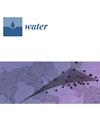Investigating the Energy Dissipation Mechanism of Piano Key Weir: An Integrated Approach Using Physical and Numerical Modeling
IF 3
3区 环境科学与生态学
Q2 ENVIRONMENTAL SCIENCES
引用次数: 0
Abstract
The enormous energy carried by discharged water poses a serious threat to the Piano Key Weir (PKW) and its downstream hydraulic structures. However, previous research on energy dissipation in PKWs has mainly focused downstream effects, and the research methods have been largely limited to physical model experiments. To deeply investigate the discharge capacity and hydraulic characteristics of PKW, this study established a PKW model with universally applicable geometric parameters. By combining physical model experiments and numerical simulations, the flow pattern of the PKW, the discharge at the overflow edges, and the variation in the energy dissipation were revealed for different water heads. The results showed that the discharge of the side wall constitutes the majority of the total discharge at low water heads, resulting in a relatively high overall discharge efficiency. As the water head increases, the proportion of discharge from the inlet and outlet keys increases, while the proportion from the side wall decreases. This change results in less discharge from the side wall and a consequent reduction in the overall discharge efficiency. The PKW exhibits superior energy dissipation efficiency under low water heads. However, this efficiency exhibits an inverse relationship with an increasing water head. The overall energy dissipation efficiency can reach 40% to 70%. Additionally, the collision of the water flows inside the outlet chamber and the mixing of the overflow jet play a primary role in energy dissipation. The findings of this study have significant implications for hydraulic engineering construction and PKW operational safety.研究琴键堰的能量耗散机制:利用物理和数值建模的综合方法
排水所携带的巨大能量对琴基堰(PKW)及其下游水工建筑物构成了严重威胁。然而,以往关于 PKW 消能的研究主要集中于下游效应,研究方法也主要局限于物理模型试验。为了深入研究 PKW 的泄洪能力和水力特性,本研究建立了一个几何参数普遍适用的 PKW 模型。通过物理模型试验和数值模拟相结合的方法,揭示了不同水头下 PKW 的流态、溢流边的排泄量以及能量耗散的变化。结果表明,在低水头时,侧壁的排水量占总排水量的大部分,因此总体排水效率相对较高。随着水位的升高,进水口和出水口水键的排水量比例增加,而侧壁的排水量比例减少。这一变化导致侧壁的排水量减少,从而降低了整体排水效率。在低水头情况下,PKW 具有出色的消能效率。然而,这种效率与水头的增加呈反比关系。总体消能效率可达 40% 至 70%。此外,出水腔内水流的碰撞和溢流射流的混合也对消能起到了主要作用。该研究结果对水利工程建设和 PKW 运行安全具有重要意义。
本文章由计算机程序翻译,如有差异,请以英文原文为准。
求助全文
约1分钟内获得全文
求助全文
来源期刊

Water
WATER RESOURCES-
CiteScore
5.80
自引率
14.70%
发文量
3491
审稿时长
19.85 days
期刊介绍:
Water (ISSN 2073-4441) is an international and cross-disciplinary scholarly journal covering all aspects of water including water science and technology, and the hydrology, ecology and management of water resources. It publishes regular research papers, critical reviews and short communications, and there is no restriction on the length of the papers. Our aim is to encourage scientists to publish their experimental and theoretical research in as much detail as possible. Full experimental and/or methodical details must be provided for research articles. Computed data or files regarding the full details of the experimental procedure, if unable to be published in a normal way, can be deposited as supplementary material.
 求助内容:
求助内容: 应助结果提醒方式:
应助结果提醒方式:


